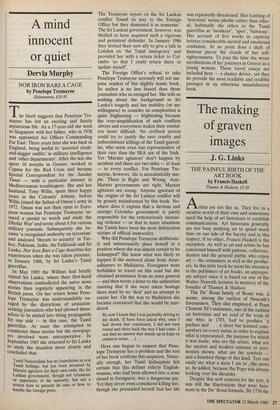The making of graven images
J. G. Links
THE PAINFUL BIRTH OF THE ART BOOK by Francis Haskell
Thames & Hudson, £5.95
Artists are not like us. They live in a creative world of their own and sometimes need the help of art historians to establish communications. Art historians generally are too busy studying art to spend much time on our side of the baurier and in this respect, if no other, Francis Haskell is the exception. As well as art and artists he has concerned himself with patrons, collectors, dealers and the general public who enjoy art — the consumers as well as the produc- ers. In this little book he turns his attention to the publishers of art books, an appropri- ate subject since it is based on one of the Walter Neurath lectures in memory of the founder of Thames & Hudson.
The De' Rossi family of Rome was, it seems, among the earliest of Neurath's forerunners. They also employed, at Pope Clement XI's insistence, one of the earliest art historians and we read of the trials of one who, in 1703, had to produce 'a preface and . . . a short but learned com- mentary on every statue in order to explain what is represented, the purpose for which it was made, who are the artists, what are the ancient and modern customs or cere- monies shown, what are the symbols — and a hundred things of this kind. You can easily see what a mess I am in', -the more so, he added, because the Pope was always looking over his shoulder.
Despite this new concern for the text, it was still the illustrations that were fore- most in the De' Rossi formula. By 1738 the firm had had its day and closed down. Conceived in Rome, the painful birth of the art book was to take place in Paris. Three midwives were in charge: Pierre Crozat, the enormously rich bachelor banker and connoisseur by whose name the book is generally known (Recueil Cro- zat); the young Comte de Caylus who bestrode the barrier between artist and art consumer; and Pierre-Jean Mariette who knew more about drawings than anyone of his day, perhaps of any day. It was the ambition of these three to produce a many-volumed history of world art, lavish- ly illustrated by the work of the best engravers to be found. For the paintings the engravers were to work direct on to the plate with the originals in front of them, instead of from copies, or copies of copies, as was the usual practice. Each drawing was to be an exact facsimile, even repro- ducing wash by a new technique. The text was to tell the reader all he could wish to know about the picture and its creator; in some cases the true creator was identified for the first time, the beginning of what Francis Haskell once called Attribution- ism. Not much of this came to pass and the project threatened at one time to ruin Crozat, but the Recueil as published proved to be an extremely important book and a very influential one.
Professor Haskell has pieced together the story from a wide variety of sources and, as would be expected, tells it with immense authority and clarity. The illus- trations, limited in size and quality as they must be in a book such as this, add much to the interest — and raise many questions. What did the buyer get for his huge outlay on the book? (He was promised a subscri- bers' list with his name in it but in the event did not even get this.) What can be the relationship of an engraving, however good its own quality, to a great painting, with the differences in size, texture — indeed almost everything except subject? How far can the purpose of the original (such as, in Francis Haskell's words, reli- gious contemplation, moral instruction, sexual arousal) be achieved? Few, even the oldest of us, received our first introduction to art from engravings although not many of any age see the world's masterpieces before they have seen reproductions of them. Are we any closer to the artist now that the intervention of the engraver, and perhaps copyist, has given way to the photographer and printer (occasionally leading to disappointment when con- fronted by the original)? I must admit these questions were provoked by the exhibition, The Image Multiplied, which recently closed at the V & A (the catalogue by Susan Lambert is still available) but they have now been revived. Involving, as they do, the whole question of the human response to art, it is not to be expected that they will be answered, but if anyone can help us place our own thoughts in order it will be Professor Haskell.



















































 Previous page
Previous page